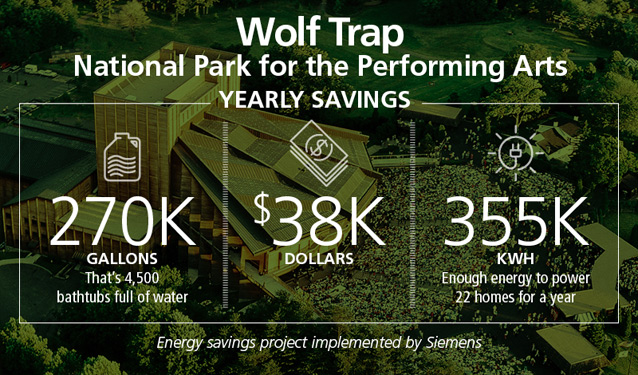The National Park Service is investing $29 million in 81 individual energy efficiency and water conservation projects at national parks throughout the greater Washington region.

NPS / Siemens
Reducing Energy Consumption
The largest source of GHG emissions at Wolf Trap originate from energy use in facilities. To reduce overall energy use and operating costs, Wolf Trap:
- Installed programmable and locked thermostats.
- Sealed and weather stripped doors and windows, or made replacements in key locations.
- Replaced and upgraded the HVAC system at the Filene Center, Administrative Office, and Ranger Station.
Energy Savings Performance Contract
As part of the larger National Capital Region (NCR) Energy Savings Performance Contract (ESPC) project, Wolf Trap:
- Replaced parking lot lights with solar lighting.
- Performed a major update of lighting fixtures and installed an Emon energy monitoring system in the Filene Center.
- Installed on-demand or tankless water heaters.
- Consolidated office space to reduce energy demand in buildings.
- Wolf Trap expects to reduce their GHG emissions by 18 percent through the ESPC.
Reducing Transportation Emissions
Wolf Trap’s second largest source of GHG emissions is from transportation. To reduce transportation-related emissions and improve transportation to and from the park, Wolf Trap:
- Implemented an annual parking workshop to review and address parking, transportation, and vehicle idling.
- Started working with local and regional transportation planning groups to develop alternative means of transportation for both visitors and employees.
- Provides shuttle bus service from the local metro station to the park during events.
Reducing Solid Waste
To help reduce solid waste, Wolf Trap:
- Established a recycling program.
- Improved internal park practices to reduce paper use and increase recycling in administrative offices.
- Included solid waste and recycling requirements in concession contracts and group permits.
- Improved recycling signage in Centerlines and other venues throughout the park.
- Considers green alternatives in all procurement decision-making.
Encouraging Carbon Sequestration through Landscape Initiatives
Carbon sequestration is a process by which carbon dioxide is removed from the atmosphere and captured in a long term storage receptacle such as a tree. Wolf Trap recognizes the importance of carbon sequestration to help mitigate or defer global warming, and to facilitate this process, the park:
- Reduced mowed areas by approximately 2 acres.
- Planted approximately 300 trees and shrubs park-wide.
Increasing Climate Change and Education Efforts
Wolf Trap’s education and outreach efforts are ongoing and extend beyond park employees to include visitors and the local community. These efforts include:
- Increasing climate education for employees and visitors.
- Reestablishing the park’s Green Team.
- Introducing Green Spot, a display operated by volunteers and park employees aimed at sharing the park’s sustainability activities and other environmental information.
- Incorporating sustainability updates into the volunteer newsletter.
- Developing employees training opportunities for all employees and volunteers about sustainability initiatives and practices.
- Encouraging and sponsoring local university students and interns to conduct sustainability initiatives.
- Using Facebook, Twitter, and press releases to share environmental messages.
Last updated: September 22, 2016
